
Sign for Peñaloza. Photo by Rhett A. Butler
A pioneering project to reduce deforestation and forest degradation in a former conflict zone in Colombia was recently granted gold certification under the Climate, Community, and Biodiversity (CCB) standard. The accreditation will help local communities access carbon finance in their efforts to safeguard biologically-rich forests.
The project is located in Colombia’s Darien region, near the border with Panama. The area is part of the Chocó, the rainforest ecosystem that runs along the Pacific coast of Colombia and Ecuador but has been heavily impacted in places by logging, mining, and clearing for agriculture and cattle ranching. The Chocó ranks as one of the most biodiverse ecosystems on Earth.
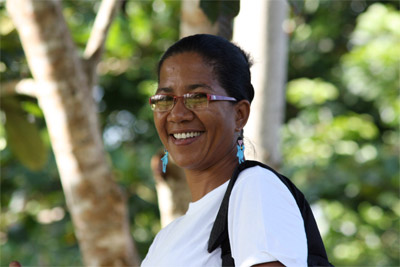 Everildys Cordoba. |
The project is led by Anthrotect, which started working with Afro-indigenous and indigenous Embera–Wounaan communities in 2007 after its founder, anthropologist Brodie Ferguson, completed research on the impact of forced displacement in the region. As families returned to their traditional lands after nearly a decade of displacement, the prospect of new conflict between armed land grabbers and communities loomed. Ferguson identified carbon finance as a potential means to help Afro-Colombian and indigenous landowners strengthen their land claims and improve natural resource management.
Everildys Cordoba is the project’s coordinator on the community side. Cordoba grew up in Penaloza, a small town not far from the Caribbean coast of Colombia and the country’s border with Panama. But in 1998, she was forcibly displaced by armed actors. Today, she has returned to her land to lead the project.
In February 2011 Cordoba took some time to answer questions from mongabay.com about her hopes for the project and what it could mean for local communities in Colombia’s Choco region.
Mongabay.com You are originally from the village of Peñaloza in Acandí, Chocó. What was it like growing up there?
Everildys Cordoba: It was a happy childhood, running, laughing, and bathing in the Tolo River.
Mongabay.com What is Cocomasur?
Everildys Cordoba: Cocomasur is a non-profit community organization that represents the Afro-descendant families that have traditionally lived along the Tolo River Basin and southern coastal zone of the municipality of Acandí, Chocó. Cocomasur operates in accordance with the legal framework established by the Colombian Constitution of 1991, particularly Law 70 and Decree 1745 [which grant land rights to Afro-indigenous communities], in addition to its own internal regulations.
Mongabay.com How did you get involved in the Choco-Darien project?
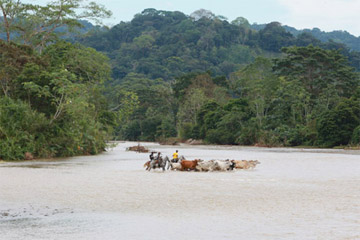 Cowboys herding cattle across a river near Penaloza. Photo by Rhett A. Butler |
Everildys Cordoba: Brodie Ferguson had been discussing the initiative with the Legal Representative of Cocomasur, Aureliano Cordoba, and Aureliano felt it would be good to involve the whole community in the design of the project. He put me in charge of communicating the idea of the project to the community in words they could understand. I had to take a complex subject and try to make it simple.
Mongabay.com Many of the project’s staff are women. What challenges do they face? What opportunities does a REDD or PES project create for women and girls in the Choco?
Everildys Cordoba: The women of Cocomasur who work for the project have the challenge of carrying out a number of administrative and operational jobs in order to implement the project according to the community’s vision. It can be quite difficult but it’s very motivating for other women in the community, especially in communities like ours where women’s responsibilities consist largely of child-raising and household chores. The project offers women in Cocomasur the opportunity to generate income from activities such as preparing food and providing logistical support for activities carried out in the field, as well as for community meetings, planning workshops, and training events. Our goal is that during the 30 year duration of the project, the girls of today will become the leaders and professionals of tomorrow, defending our rights and keeping our communities united.
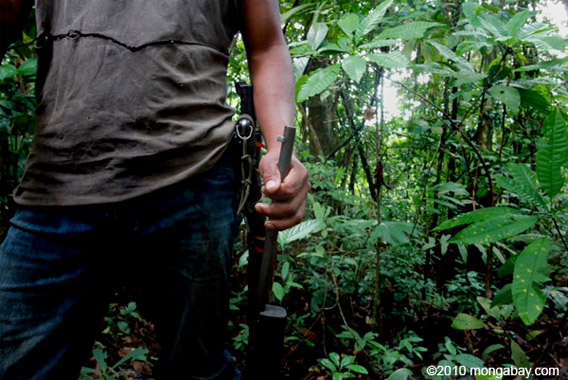
Mongabay.com What can REDD and payment for ecosystem services offer to communities in conflict or post-conflict settings like the Choco?
Everildys Cordoba: It’s an opportunity to acquire the tools needed to promote and strengthen community organizational capacity, to improve quality of life, and to empower communities to manage and defend their territory.
Mongabay.com Why are forests important to your community?
Everildys Cordoba: Forests are an integral part of our lives. They have always been there — for those who are no longer with us, for those of us who are alive today, and if we take care of them, they will be around for future generations. It’s because of the forests that we have water and food, and thanks to our land title, we now have the opportunity to provide a service to the world and generate income for our community.
Mongabay.com What are the primary reasons people cut down forests in your region?
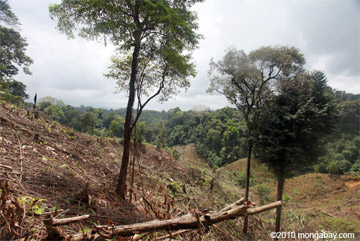 Illegal forest clearing by colonists in an Afro-indigenous reserve. Photo by Rhett A. Butler. |
Everildys Cordoba: The main reason people clear forests is to create pasture. Extensive cattle ranching is the largest threat to forests in our region.
Mongabay.com What does Cocomasur hope to achieve through the project?
Everildys Cordoba: We hope to grow stronger as a community organization through investment in the recuperation of our cultural identity and in territorial planning and management.
Mongabay.com Can you tell us more about benefits? What form do they take, and how are they distributed?
Everildys Cordoba: Project benefits are envisioned to be collective, just like our territory. In the design phase of the project, we worked with our local councils to define priorities and identify the activities in which the project should invest. Among the possibilities discussed, livelihood activities and sustainable forest management were the more important priorities.
With the support of Anthrotect, Cocomasur has been able to improve its administrative capacity. The knowledge and experience that we’re gaining in this respect will be transferred to the local councils within Cocomasur, so that in time, they too will be able to take charge of managing projects.
Since starting last year, the project has resulted in at least 12 direct jobs and around 40 indirect jobs. Every day we are growing.
Mongabay.com: What has been the most important or inspirational moment for you so far?
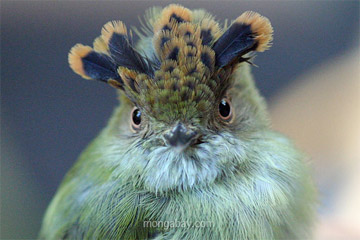 Mongabay.com has been voluntarily offsetting CO2 emissions generated from operations (servers, data transfer, travel, equipment) via the Chocó-Darién Corridor project since 2009. The region serves as a habitat for mongabay’s mascot: the scale-crested pygmy tyrant. Photo by Rhett A. Butler. |
Everildys Cordoba: It’s impossible to choose a single moment—there have been many. But during this whole process, there were three moments in particular that stand out as the happiest. First, the day of the Cocomasur General Assembly on October 9, 2010, when over 100 participating community members approved the project; second, the strategic planning workshop held in August, 2011, with the participation of the communities of Cocomasur; and finally, on February 15, 2012 when Aureliano, Brodie, and I received the news of the Gold Level CCB validation together.
Biodiversity in the forest around Penalosa

Anisocelis flavolineata flag-footed bug

Green and Black Poison Dart Frog (Dendrobates auratus)

Rainforest of the Darien

Green iguana

Butterfly
Related articles
REDD in Colombia: using forests to finance conservation and communities in Colombia’s Choco, a former war zone

(11/03/2009) Reducing Emissions from Deforestation and Degradation (REDD), a climate change mechanism proposed by the U.N., has been widely lauded for its potential to simultaneously deliver a variety of benefits at multiple scales. But serious questions remain, especially in regard to local communities. Will they benefit from REDD? While much lip-service is paid to community involvement in REDD projects, many developers approach local communities as an afterthought. Priorities lie in measuring the carbon sequestered in a forest area, lining up financing, and making marketing arrangements, rather than working out what local people — the ones who are often cutting down trees — actually need in order to keep forests standing. This sets the stage for conflict, which reduces the likelihood that a project will successfully reduce deforestation for the 15-30 year life of a forest carbon project. Brodie Ferguson, a Stanford University-trained anthropologist whose work has focused on forced displacement of rural communities in conflict regions in Colombia, understands this well. Ferguson is working to establish a REDD project in an unlikely place: Colombia’s Chocó, a region of diverse coastal ecosystems with some of the highest levels of endemism in the world that until just a few years ago was the domain of anti-government guerrillas and right-wing death squads.